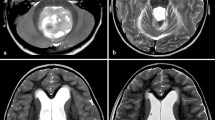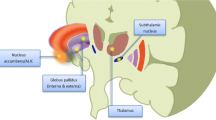Abstract
Oculopalatal tremor (OPT) is an acquired pathology characterized by continuous and rhythmical soft palatal movements combined with pendular nystagmus. Aside from vascular lesions, oncological masses affecting the dentatorubro-olivary pathway can impair brainstem and/or cerebellar pathways, manifesting as dyssynchronous movement. In this review, we delve into the neurophysiology of OPT along with oncological causes and treatment options based on the most recent clinical trial data. This literature review includes medication treatment data from clinical trials enrolling individuals with features of OPT, including acquired pendular nystagmus (APN). Trials were deemed eligible for inclusion in this review if one or more participants had symptoms determined by the trial authors to be caused by OPT. Trials investigating the treatment of APN secondary to a separate cause, such as multiple sclerosis, were excluded from this review. Several early treatments failed to demonstrate a benefit for patients with APN due to OPT. Trials of anticholinergic agents were largely ineffective and poorly tolerated. Botulinum toxin A demonstrated improvement in APN symptoms. Most recently, trials including memantine and gabapentin have demonstrated success with attenuation of APN. Surgical modalities such as DBS have yet to show improvement, though with only a single case report as evidence. Oculopalatal tremor is a unique manifestation of posterior fossa tumors disrupting the Guillain–Mollaret triangle. Symptom control through medication management has had limited success attributed to poor response and medication intolerance. Surgical modalities like DBS may have an emerging role in OPT treatment by targeting dyssynchronous activity in the dentatorubro-olivary pathway.
Similar content being viewed by others
References
Spencer H (1886) Pharyngeal and laryngeal “nystagmus.” Lancet 128(3293):702. https://doi.org/10.1016/s0140-6736(01)78357-2
Borruat FX (2013) Oculopalatal tremor: current concepts and new observations. Curr Opin Neurol 26(1):67–73. https://doi.org/10.1097/WCO.0b013e32835c60e6
Jang L, Borruat FX (2014) Oculopalatal tremor: variations on a theme by Guillain and Mollaret. Eur Neurol 72(3–4):144–149. https://doi.org/10.1159/000360531
Bandini F, Castello E, Mazzella L, Mancardi GL, Solaro C (2001) Gabapentin but not vigabatrin is effective in the treatment of acquired nystagmus in multiple sclerosis: how valid is the GABAergic hypothesis? J Neurol Neurosurg Psychiatry 71(1):107–110. https://doi.org/10.1136/jnnp.71.1.107
Starck M, Albrecht H, Pöllmann W, Dieterich M, Straube A (2010) Acquired pendular nystagmus in multiple sclerosis: an examiner-blind cross-over treatment study of memantine and gabapentin. J Neurol 257(3):322–327. https://doi.org/10.1007/s00415-009-5309-x
Starck M, Albrecht H, Pöllmann W, Straube A, Dieterich M (1997) Drug therapy for acquired pendular nystagmus in multiple sclerosis. J Neurol 244(1):9–16. https://doi.org/10.1007/pl00007728
Kim JI, Averbuch-Heller L, Leigh RJ (2001) Evaluation of transdermal scopolamine as treatment for acquired nystagmus. J Neuroophthalmol 21(3):188–192. https://doi.org/10.1097/00041327-200109000-00005
Leigh RJ, Burnstine TH, Ruff RL, Kasmer RJ (1991) Effect of anticholinergic agents upon acquired nystagmus: a double-blind study of trihexyphenidyl and tridihexethyl chloride. Neurology 41(11):1737–1741. https://doi.org/10.1212/wnl.41.11.1737
Repka MX, Savino PJ, Reinecke RD (1994) Treatment of acquired nystagmus with botulinum neurotoxin A. Arch Ophthalmol 112(10):1320–1324. https://doi.org/10.1001/archopht.1994.01090220070025
Wang D, Sanchez J, Foote KD, Sudhyadhom A, Bhatti MT, Lewis S, Okun MS (2009) Failed DBS for palliation of visual problems in a case of oculopalatal tremor. Parkinsonism Relat Disord 15(1):71–73. https://doi.org/10.1016/j.parkreldis.2008.01.020
Koeppen AH, Barron KD, Dentinger MP (1980) Olivary hypertrophy: histochemical demonstration of hydrolytic enzymes. Neurology 30(5):471–480. https://doi.org/10.1212/wnl.30.5.471
Nerrant E, Abouaf L, Pollet-Villard F, Vie AL, Vukusic S, Berthiller J, Colombet B, Vighetto A, Tilikete C (2020) Gabapentin and memantine for treatment of acquired pendular nystagmus: effects on visual outcomes. J Neuroophthalmol 40(2):198–206. https://doi.org/10.1097/wno.0000000000000807
Thurtell MJ, Joshi AC, Leone AC, Tomsak RL, Kosmorsky GS, Stahl JS, Leigh RJ (2010) Crossover trial of gabapentin and memantine as treatment for acquired nystagmus. Ann Neurol 67(5):676–680. https://doi.org/10.1002/ana.21991
Shaikh AG, Thurtell MJ, Optican LM, Leigh RJ (2011) Pharmacological tests of hypotheses for acquired pendular nystagmus. Ann N Y Acad Sci 1233(1):320–326. https://doi.org/10.1111/j.1749-6632.2011.06118.x
Averbuch-Heller L, Tusa RJ, Fuhry L, Rottach KG, Ganser GL, Heide W, Büttner U, Leigh RJ (1997) A double-blind controlled study of gabapentin and baclofen as treatment for acquired nystagmus. Ann Neurol 41(6):818–825. https://doi.org/10.1002/ana.410410620
Turgut AC, Tubbs RS, Turgut M (2021) Georges Charles Guillain (1876–1961) and Pierre Mollaret (1898–1987) and their legacy to neuroanatomy: the forgotten triangle of Guillain–Mollaret. Childs Nerv Syst 37(2):349–350. https://doi.org/10.1007/s00381-018-04033-8
Wein S, Yan B, Gaillard F (2015) Hypertrophic olivary degeneration secondary to pontine haemorrhage. J Clin Neurosci 22(7):1213–1214. https://doi.org/10.1016/j.jocn.2015.02.005
Guillain G (1938) The syndrome of synchronous and rhythmic palato-pharyngo-laryngo-oculo-diaphragmatic myoclonus: (section of neurology). Proc R Soc Med 31(9):1031–1038
Gambardella A, Zappia A, Valentino P, Aguglia U, Fera F, Pardatscher K, Quattrone A (1997) Action palatal tremor in a patient with primary intestinal lymphoma. Mov Disord 12(5):794–797. https://doi.org/10.1002/mds.870120530
Posterior fossa tumor (2021) MedlinePlus medical encyclopedia. https://medlineplus.gov/ency/article/001404.htm. Accessed 22 May 2021
Richard HT, Fuller CE (2016) Hemangioblastoma. In: Adesina AM, Tihan T, Fuller CE, Poussaint TY (eds) Atlas of pediatric brain tumors, 2nd edn. Springer, pp 143–148
Hirano M, Hatzoglou V, Karimi S, Young RJ (2015) Hypertrophic olivary degeneration resulting from posterior fossa masses and their treatments. Clin Imaging 39(5):787–790. https://doi.org/10.1016/j.clinimag.2015.05.015
Cervio A, Villalonga JF, Mormandi R, Alcorta SC, Sevlever G, Salvat J (2017) Surgical treatment of cerebellar hemangioblastomas. Surg Neurol Int 8:163. https://doi.org/10.4103/sni.sni_490_16
Yin X, Duan H, Yi Z, Li C, Lu R, Li L (2020) Incidence, prognostic factors and survival for hemangioblastoma of the central nervous system: analysis based on the surveillance, epidemiology, and end results database. Front Oncol 10:570103. https://doi.org/10.3389/fonc.2020.570103
Kestle J, Townsend JJ, Brockmeyer DL, Walker ML (2004) Juvenile pilocytic astrocytoma of the brainstem in children. J Neurosurg 101(1 Suppl):1–6. https://doi.org/10.3171/ped.2004.101.2.0001
Juvenile Pilocytic Astrocytoma. NORD (National Organization for Rare Disorders). https://rarediseases.org/rare-diseases/juvenile-pilocytic-astrocytoma/. Accessed 22 May 2021
Gilbertson RJ (2004) Medulloblastoma: signalling a change in treatment. Lancet Oncol 5(4):209–218. https://doi.org/10.1016/S1470-2045(04)01424-X
Bautista F, Fioravantti V, de Rojas T, Carceller F, Madero L, Lassaletta A, Moreno L (2017) Medulloblastoma in children and adolescents: a systematic review of contemporary phase I and II clinical trials and biology update. Cancer Med 6(11):2606–2624. https://doi.org/10.1002/cam4.1171
Phatouros CC, McConachie NS (1998) Hypertrophic olivary degeneration: case report in a child. Pediatr Radiol 28(11):830–831. https://doi.org/10.1007/s002470050475
Gatto L, Franceschi E, Nunno VD, Tomasello C, Bartolini S, Brandes AA (2020) Glioneuronal tumors: clinicopathological findings and treatment options. Future Neurol. https://doi.org/10.2217/fnl-2020-0003
Flanigan RC, Campbell SC, Clark JI, Picken MM (2003) Metastatic renal cell carcinoma. Curr Treat Options Oncol 4(5):385–390. https://doi.org/10.1007/s11864-003-0039-2
Meningioma (2021) John Hopkins University. https://www.hopkinsmedicine.org/health/conditions-and-diseases/meningioma. Accessed 22 May 2021
Nguyen TH, Pham T, Strickland T, Brewer D, Belirgen M, Al-Rahawan MM (2018) Von Hippel-Lindau with early onset of hemangioblastoma and multiple drop-metastases like spinal lesions: a case report. Medicine (Baltimore) 97(39):e12477. https://doi.org/10.1097/MD.0000000000012477
Ding C, Tihan T (2019) Recent progress in the pathology and genetics of pilocytic and pilomyxoid astrocytomas. Balkan Med J 36(1):3–11. https://doi.org/10.4274/balkanmedj.2018.1001
Millard NE, De Braganca KC (2016) Medulloblastoma. J Child Neurol 31(12):1341–1353. https://doi.org/10.1177/0883073815600866
Blumcke I, Wiestler OD (2002) Gangliogliomas: an intriguing tumor entity associated with focal epilepsies. J Neuropathol Exp Neurol 61(7):575–584. https://doi.org/10.1093/jnen/61.7.575
Ghai S, Pattison J, Ghai S, O’Malley ME, Khalili K, Stephens M (2007) Primary gastrointestinal lymphoma: spectrum of imaging findings with pathologic correlation. Radiographics 27(5):1371–1388. https://doi.org/10.1148/rg.275065151
Tilikete C, Desestret V (2017) Hypertrophic olivary degeneration and palatal or oculopalatal tremor. Front Neurol. https://doi.org/10.3389/fneur.2017.00302
Lopez LI, Bronstein AM, Gresty MA, Du Boulay EP, Rudge P (1996) Clinical and MRI correlates in 27 patients with acquired pendular nystagmus. Brain 119(Pt 2):465–472. https://doi.org/10.1093/brain/119.2.465
Funding
The authors have not received any funding for this work from any organization.
Author information
Authors and Affiliations
Corresponding author
Ethics declarations
Conflict of interest
The authors report no conflict of interest concerning the materials or methods used in this study or the findings specified in this paper.
Additional information
Publisher's Note
Springer Nature remains neutral with regard to jurisdictional claims in published maps and institutional affiliations.
Rights and permissions
About this article
Cite this article
Fiani, B., Runnels, J., Sarhadi, K. et al. Oncologic causes of oculopalatal tremors: neurophysiology and treatment. Acta Neurol Belg 121, 1111–1116 (2021). https://doi.org/10.1007/s13760-021-01761-8
Received:
Accepted:
Published:
Issue Date:
DOI: https://doi.org/10.1007/s13760-021-01761-8




